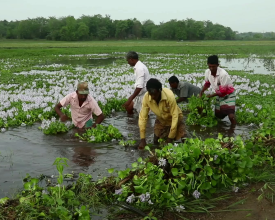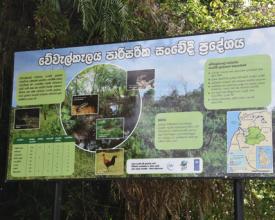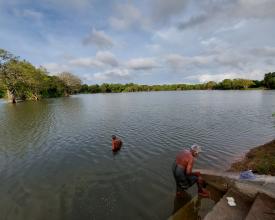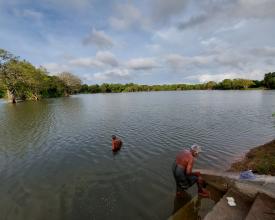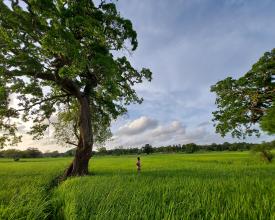Environmentally Sensitive Areas: A Story of Conservation, Development and Resilience
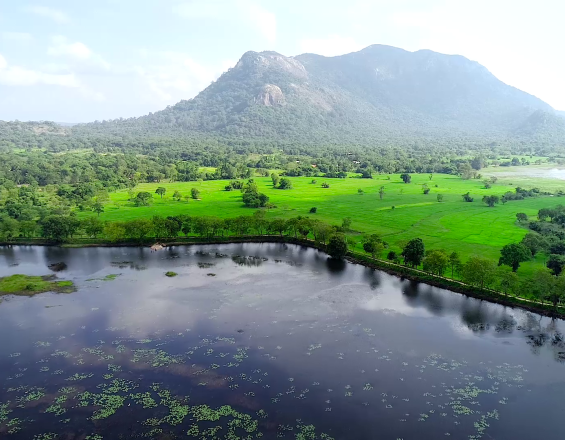
Sri Lanka, though small in size, is part of a global Biodiversity Hotspot due to its rich biodiversity and increasing threats from habitat encroachment, unsustainable resource use, pollution, and invasive species. While 28% of the country is covered by Protected Areas (PAs), many critical ecosystems exist outside these zones. Recognizing this, the Ministry of Environment and UNDP, with funding from the GEF, implemented a co-management approach in Environmentally Sensitive Areas (ESAs) landscapes with high biodiversity and ecosystem service value outside formal PAs. The approach engaged public and private sectors, along with local communities, to conserve biodiversity while sustaining the ecological and socio-economic benefits essential to surrounding populations. It promoted inclusive and sustainable management practices, balancing conservation with responsible resource use, and enabling collaborative agreements between communities and the government. This approach is vital to safeguard Sri Lanka’s unique biodiversity.
Context
Challenges addressed
The main challenges threatening biodiversity include deforestation for chena cultivation, unsustainable farming such as mono-cropping, overuse of agrochemicals, pollution, and limited awareness of biodiversity’s value. Low agricultural productivity leads to land encroachment, weak incomes from agriculture and tourism due to poor value chains and market access, and social issues such as the gender pay gap. Inadequate capacity in environmental governance creates distrust between communities and government agencies. Climate change further intensifies these threats through more frequent and severe droughts, floods, and temperature extremes, accelerating land and forest degradation, freshwater scarcity, and biodiversity loss. These impacts erode ecosystem services and traditional livelihoods, especially for vulnerable groups. Underlying causes include weak institutional coordination across sectors, lack of biodiversity-sensitive planning, and insufficient public and political commitment to conservation.
Location
Process
Summary of the process
The three components of the Co-Management Plan development process were biodiversity assessment, threats and trends assessment, and participatory planning that were interconnected and mutually reinforcing. The biodiversity assessment provides the foundational ecological knowledge needed to understand what is being protected and why it is important. Building on this baseline, the threats and trends assessment identifies the pressures acting on biodiversity and projects how these may evolve, ensuring that decisions are informed by both current realities and future risks. These two evidence-based layers directly feed into participatory planning, where communities and stakeholders use the scientific findings to design practical, locally grounded management strategies. The participatory planning process strengthens ownership, enhances the implementability of actions, and ensures that conservation measures are socially acceptable and aligned with livelihoods. Together, these three components create a continuous feedback system science informs planning, planning responds to threats, and community engagement ensures sustainability—ultimately producing a robust, adaptive, and effective Co-Management Plan.
Building Blocks
Co-Management approach
collaborative approach where local communities and authorities share responsibility and decision-making for managing natural resources—such as forests, fisheries or ESAs—helps balance conservation with community needs, improve compliance, build trust and ensure long-term sustainability.
Wewalkele, one of the pilot ESAs, is home to several threatened species including the Thamba-laya (Labeo lankae), Leopard, Fishing cat, Elephant and Eurasian otter. Among its 125 flora species, tall and dense cane (Calamus) grows in muddy, thorny groves. Surrounding villages harvest Heen Wewal for handicrafts, often through unsustainable methods that supplement their income.
Recognizing Wewalkele’s biodiversity value and emerging threats, the Divisional Secretariat and community formed a Local Management Committee (LMC) in 2018 to develop a Co-Management Plan. The area was socially surveyed and physically demarcated to prevent encroachment and ensure conservation targets.
To leave no one behind, the project supported communities to shift from unsustainable harvesting to green jobs—improving skills, strengthening market linkages and promoting value-added cane products. Cane nurseries and replanting facilities were established to secure long-term livelihoods. Strong partnerships between local authorities, communities and the LMC ensured the ESA’s success. Wewalkele shows that communities, habitats and biodiversity can co-exist and thrive.
Enabling factors
1. Clear Legal and Policy Framework
2. Strong Local Institutions and Leadership
3. Trust and Effective Communication
4. Equitable Benefit Sharing
5. Capacity Building
6. Consistent Government Support
7. Adaptive Management and Monitoring
Lesson learned
One of the key lessons learned is that the absence or vagueness of legal and policy frameworks for co-management has limited the effectiveness and sustainability of ESA interventions at the initial stage of the project. Where clear, recognized backing was formed, community roles were more respected, rights were defined, and conservation outcomes become more enduring......
Equitable benefit sharing is essential to the success of ESA co-management. In the Wewalkele ESA, conservation efforts were designed to align with local livelihoods, particularly by enhancing the cane-based handicraft industry. Through training, market linkages, and institutional support, communities gained stable incomes while actively contributing to biodiversity conservation. This mutually beneficial arrangement demonstrates that when communities share both the responsibilities and rewards of managing an ESA, conservation efforts become more inclusive, participatory, and sustainable.
Resources
Rediscovering and implementing traditional knowledge
This is to revive, preserve, and apply Indigenous and local knowledge systems that have historically supported the sustainable use and conservation of biodiversity in and around the cascade ecosystem. These knowledge systems have deeply rooted in centuries of interaction with ecosystems, offering practical, time-tested methods for managing natural resources in ways that maintain ecological balance. By integrating this knowledge with modern conservation science, biodiversity efforts become more culturally respectful, inclusive, and effective. Sri Lanka: The tank cascade systems (Elangawa) are ancient water management practices that support aquatic biodiversity and rice cultivation in dry zones.
- Village elders and traditional irrigation managers (Vel Vidane) knew when to open and close sluice gates based on the timing and pattern of monsoon rains, not fixed calendars. They rely on subtle signs such as the first call of migratory birds, flowering of trees, or moisture in soil layers to make water release decisions—practices rooted in observation, not engineering manuals.
- Farmers traditionally maintain vegetated buffer zones (Kattakaduwa) at the downstream edge of the tank to filter salts, protect water quality, and maintain soil health. This practice was not scientifically explained in the past, but local communities knew that removing these vegetated zones harmed crops and water quality.
- Local farmers have an intuitive sense of where sediment settles, how to periodically dredge, and how to reuse silt to improve soil fertility. Such practices have helped sustain tanks over centuries without formal hydrological models.
- Communities understand the presence of birds, fish, and reptiles in and around tanks as part of the ecosystem's health—some even avoid disturbing nesting areas or harvest fish only after spawning periods, even in absence of formal rules.
Enabling factors
- Community Memory and Continuity of Use
- Cultural and Religious Significance
- Legal and Institutional Recognition
- Scientific Validation and Partnerships
- Community-Based Organizations and Farmer Societies
- NGO and Donor Support
- Global Recognition (e.g., GIAHS Status)
Lesson learned
- Projects that revived tank cascade systems were more successful when roles of farmers' societies and state agencies were formalized in agreements or supported by local policies. where no formal recognition existed, community efforts sometimes collapsed after project funding ended.
Impacts
This Solution established a biodiversity-friendly environment without compromising the sustainable economic development of surrounding communities. By enabling local communities and stakeholders to collectively design and drive conservation oriented interventions, it fostered a strong sense of ownership, while economic benefits provided added incentives for conservation. The Environmentally Sensitive Areas (ESA) management approach promoted a holistic model for biodiversity conservation and integrated land-use planning among relevant government agencies. The project identified and managed 23,253 ha as ESAs; introduced biodiversity compatible production practices across 23,763 ha; and integrated 183,957 ha of Protected Areas into broader landscape and seascape management plans. It pilot-tested ESA management models over 18,439 ha of diverse habitats, including forests, tank cascades, coastal ecosystems, and isolated hills outside protected areas. This helped establish the governance framework needed to operationalize ESA and foster strong stakeholder collaboration at pilot sites in Manawakanda, Kala Oya Riverine, Gangewadiya, Villu, and Wewalkale. Based on these models, the Ministry of Environment developed and the Cabinet of Ministers approved a National ESA Policy to enable sustainable, inclusive development while conserving biodiversity outside protected areas.
Beneficiaries
- Local communities, paddy and other crop farmers – both male and female, farmer organizations, local agro-businesses
- Local government agencies like the Forest department, wildlife department, agriculture department, and divisional secretariats
Global Biodiversity Framework (GBF)
Sustainable Development Goals
Story
Habarawatte, a village on the outskirts of Galnewa in Sri Lanka’s Anuradhapura district, offers an unexpectedly lush landscape despite its dry-zone classification. Stretching fields of emerald paddy, clusters of trees like Mee and Kumbuk, and the shimmering village reservoir create a scene of rural tranquility.
This serenity is recent. Only a few years ago, Habarawatte suffered from severe aridity, with villagers struggling to cultivate their land. Its transformation is the result of a community-driven effort supported by the Provincial Department of Irrigation. The initiative revived an ancient ecological practice—the cascaded tank-village system (Ellangawa). Led by the Global Environment Facility (GEF), the Ministry of Environment, and UNDP, the “Enhancing Biodiversity Conservation and Sustenance of Ecosystem Services in Environmentally Sensitive Areas Project” restored the system in the Kandulugamuwa GN Division, bringing visible change to the village.
Habarawatte borders the Kahalla-Pallekelle Forest and Sanctuary, a Protected Area managed by the Forest Department and the Department of Wildlife Conservation. Villages adjacent to protected areas are vital for biodiversity conservation and ecosystem balance. For this reason, Habarawatte was identified as an Environmentally Sensitive Area (ESA). The ESA contains significant biodiversity and provides key ecosystem services. The pilot project focused on working with the community to restore the long-defunct ellangawa- cascade.
The Birth of a Champion
Through this initiative, the ESA Project revived a sustainable land-use planning and management approach that now enables the community to gain steady economic benefits while protecting a vital environmentally sensitive area. “We had only heard about the ellangawa of the ancient kings, but never seen it,” says Neil Jayawardena, Chairman of the Habarawatte Farmers Society. “Earlier we could farm only once a year when the rains came, but after the project, everything has changed.”
Before they were renovated, Habarawatte’s defunct tanks were a part of a complex irrigation system that was developed by the ancient Sinhalese more than two millennia ago. The cascaded tank-village system, or ellangawa, is a series of tanks or minor reservoirs that were organized within a micro-catchment of the dry-zone landscape.



